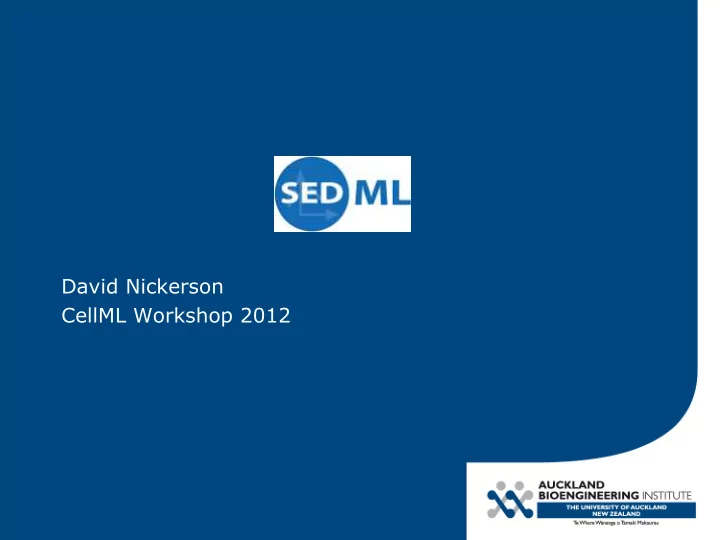

David Nickerson CellML Workshop 2012
Reproducible ¡simula0on ¡experiments ¡with ¡SED-‑ML ¡ 13.03.2012 ¡ Dagmar ¡Waltemath ¡ www.sbi.uni-‑rostock.de ¡
The ¡necessity ¡for ¡reproducible ¡science ¡ Fig.: Example simulation results (Le Novère, Neuroinformatics (2010)) www.sbi.uni-‑rostock.de ¡ 3
Similarly for complex models! × time × patient × drug dose × … 4
Similarly for complex models! × time × patient × drug dose × … 5
SED-‑ML ¡Mo0va0on ¡ Biological publication repository Simulation tool ? models Simulation result www.sbi.uni-‑rostock.de ¡ 6
SED-‑ML ¡Mo0va0on ¡ “[..] in Biomodels database the model BIOMD0000000139 and BIOMD0000000140 are two different models and they are supposed to show different results . Unfortunately simulating them in Copasi gives same result for both the models. [..] “ (arvin mer on sbml-discuss) Fig.: running model files (COPASI simulation tool) www.sbi.uni-‑rostock.de ¡
SED-‑ML ¡Mo0va0on ¡ “[..] in Biomodels database the model BIOMD0000000139 and BIOMD0000000140 are two different models and they are supposed to show different results . Unfortunately simulating them in Copasi gives same result for both the models. [..] “ (arvin mer on sbml-discuss) Fig.: running model files (COPASI simulation tool) www.sbi.uni-‑rostock.de ¡
SED-‑ML ¡Mo0va0on ¡ BIOMD0000000139 , BIOMD0000000140 Simulation models Simulation results (SBW Workbench) www.sbi.uni-‑rostock.de ¡ 9
SED-‑ML ¡Level ¡1 ¡Version ¡1 ¡ Levels: major revisions containing substantial changes Versions: minor revisions containing corrections and refinements Editorial board: coordinates SED-ML development (elected by sed-ml-discuss members) SED-ML Level 1 Version 1: • multiple models • multiple simulation setups • time course simulations • no “nested simulation” • only explicit model entities can be addressed (XPath) www.sbi.uni-‑rostock.de ¡ 10
11
Main ¡building ¡blocks ¡ Figure: SED-ML structure (Waltemath et al., 2011) www.sbi.uni-‑rostock.de ¡ 12
SED-‑ML ¡– ¡What ¡does ¡it ¡look ¡like? ¡ www.sbi.uni-‑rostock.de ¡ 13
SED-‑ML ¡– ¡What ¡does ¡it ¡look ¡like? ¡ next reaction method www.sbi.uni-‑rostock.de ¡ 14
Example: ¡Running ¡a ¡simple ¡model ¡of ¡spiking ¡neurons ¡ www.sbi.uni-‑rostock.de ¡ 15
Example: ¡What ¡is ¡encoded ¡in ¡the ¡model ¡ 1 compartment 1 standard species No reactions 8 global quantities (parameters) 2 rate rules 2 events www.sbi.uni-‑rostock.de ¡ 16
Example: ¡What ¡is ¡encoded ¡in ¡the ¡model ¡ Model available from BioModels DB : urn:miriam:biomodels.db:BIOMD0000000127 Representing the Simple model of spiking neurons published by Izhikevich (2003) in urn:miriam:pubmed:18244602 Model is for organism mammals urn:miriam:taxonomy:40674 1 compartment is version of a cellular compartment urn:miriam:obo.go:GO%3A0005623 1 standard species No reactions 8 global quantities (parameters) 2 rate rules encoded: the regulation of membrane potential (variable v ) urn:miriam:obo.go:GO%3A0042391, the positive regulation of potassium ion transport (variable U ) urn:miriam:obo.go:GO%3A0043268 2 events encoded: a version of the stabilization of membrane potential (event event_0000001) urn:miriam:obo.go:GO%3A0030322, and the detection of electrical stimulus (event Stimulus) urn:miriam:obo.go:GO%3A0050981 www.sbi.uni-‑rostock.de ¡ 17
Example: ¡What ¡happens ¡if ¡I ¡just ¡simulate? ¡ First attempt to run the model, measuring the spiking rate v over time ñ load SBML into the simulation tool COPASI ñ use parametrisation as given in the SBML file ñ define output variables ( v ) ñ run the time course 1 ms (standard) 100ms 1000ms www.sbi.uni-‑rostock.de ¡ 18
Example: ¡What ¡happens ¡if ¡I ¡just ¡simulate? ¡ Second attempt to run the model, adjusting simulation step size and duration Fig.: COPASI simulation, duration: 140ms, Fig: reference publication step size: 0.14 www.sbi.uni-‑rostock.de ¡ 19
Example: ¡What ¡happens ¡if ¡I ¡just ¡simulate? ¡ Third attempt to run the model, updating initial model parameters Fig.: reference publication Fig.: COPASI, adjusted parameter values (a=0.02, b=0.2 c=-55, d=4 ) www.sbi.uni-‑rostock.de ¡ 20
21
22
How ¡to ¡contribute ¡to ¡SED-‑ML ¡ 1. Have a look at the current SED-ML Specification document on http://sed-ml.org 2. Try out some of the existing examples http://sed-ml.org and http://sourceforge.net/projects/libsedml 3. Identify what is missing for you to encode your simulation experimental setups - What can you not express? 4. Submit a feature request & post it on the list feature request tracker: http://sourceforge.net/projects/sed-ml mailing list: sed-ml-discuss@lists.sourceforge.net 1. … submit a proposal with example files and prototype proposal tracker: http://sourceforge.net/projects/sed-ml www.sbi.uni-‑rostock.de ¡ 23
Recommend
More recommend